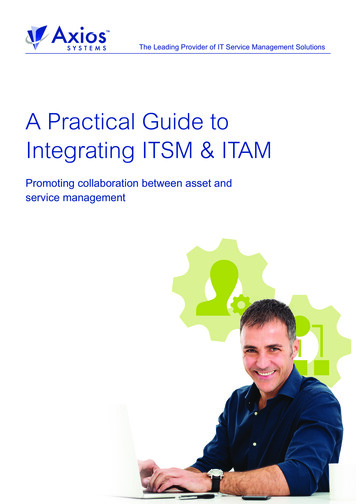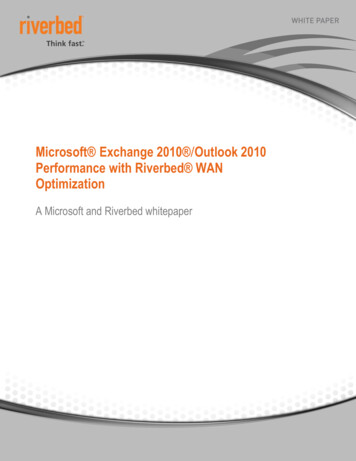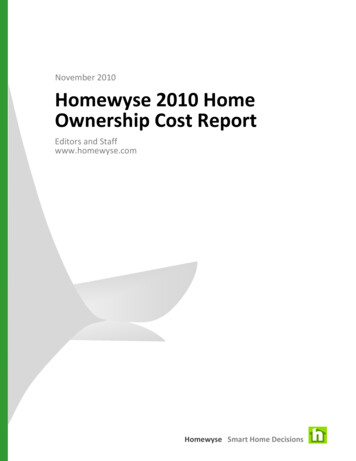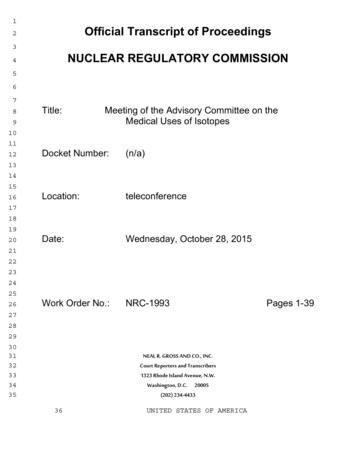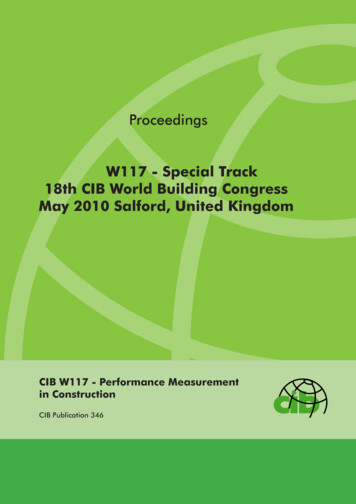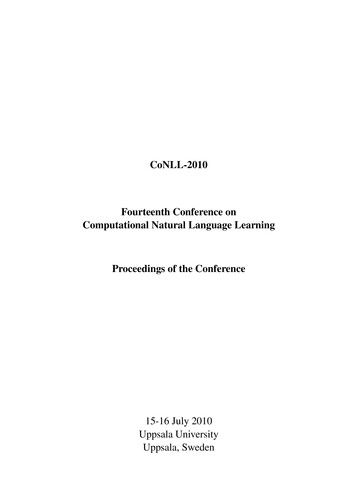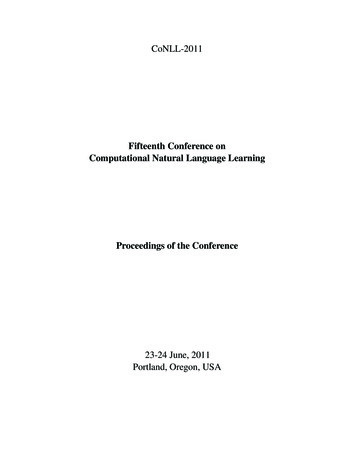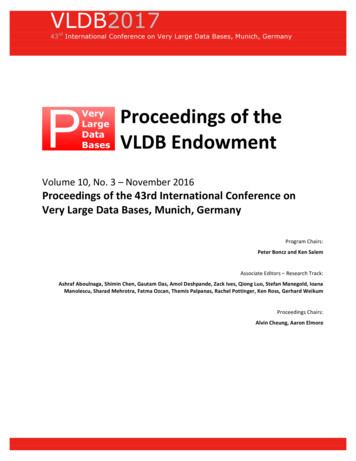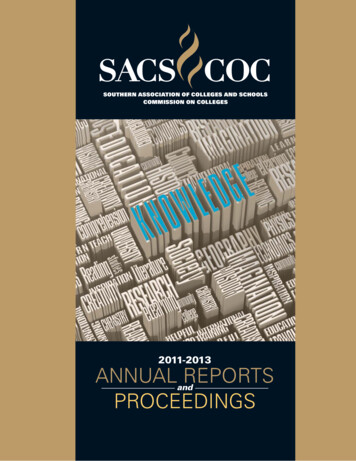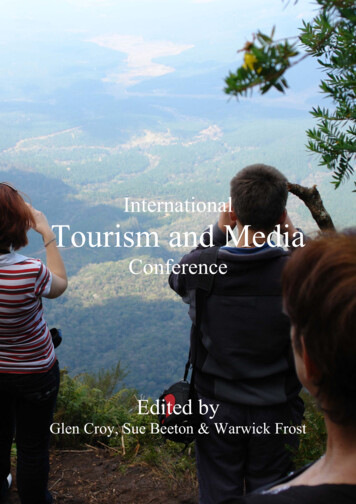
Transcription
InternationalTourism and MediaConferenceEdited byGlen Croy, Sue Beeton & Warwick Frost
International Tourism and MediaConferenceEdited byGlen Croy, Sue Beeton and Warwick FrostCo-Convened byTourism Research Unit, Monash UniversityandSchool of Management, La Trobe UniversityHosted atMonash University Prato11th-13th July 2010
Croy, G., Beeton, S., and Frost, W. (2010) International Tourism and MediaConference. 11th-13th July. Tourism Research Unit Monash Universityand School of Management La Trobe University: Prato.Cover Photo: God’s Window, Mpumalanga, South Africa – Glen Croy
International Tourism and Media Conference 2010Table of ContentsConference Schedule. 1Film Tourism Impacts and Stakeholders: DMOs’ Role to ManageGlen Croy, Marieke Kersten . 3The Creation and Mediation of News Media’s Images of TouristDestinations: Conceptions and Intentions among Swedish TravelJournalists and their Main SourcesKristina Lindström . 9The Brunello Crisis: Media Role and its Impact on Wine Reputationand Tourist FlowsAlessio Cavicchi, Cristina Santini, Elena Beccacece. 13Media Convergence: Tourist Attractions in MakingMaria Månsson. 16The Influence of a Film on Destination Image and the Desire to Travel:A Cross Cultural ComparisonSimon Hudson, Youcheng Wang, Sergio Moreno Gil. 19Can Film Tourism be Profitable? The case of MovieToursSue Beeton . 23Films and Audiovisual Potentiality in Tourism Destination Promotion:Points of View and Choices of European Destination ManagersFrancesco di Cesare, Anthony A. La Salandra . 24To Identify the Future Viability of Using the Film Induced TourismConcept to Promote Ireland as Tourism DestinationNoëlle O'Connor, Peter Bolan. 27Cultural Heritage Tourism and the Media: The Case of Ned KellyFiona Wheeler, Warwick Frost . 31Constructing the Screen-Tourist Experience: A Popular TelevisionDrama Production PerspectiveSangkyun Kim, Noëlle O'Connor . 35In a Galaxy Far, Far away? Film Tourism and SustainabilityAnne Buchmann. 40Missing Identity: Relocation of Budapest in film-induced tourismAnna Irimiás, Tamara Rátz . 44i
International Tourism and Media Conference 2010Television travel diaries – impact on destination imagePetra Glover . 47Women, the Media and the Italian DreamJennifer H. Laing . 50The Power of TV Dramas: Fans as Volunteer TouristsJun Shao, Michelle Scarpino, Ulrike Gretzel . 54Destination Sunset Boulevard: Tourism and the Film Noir GenreGary Best, Jennifer Laing, Sue Beeton, Warwick Frost . 57ii
International Tourism and Media Conference 2010Conference ScheduleMonday 12 July9amRegistration and Welcome9.30amPaper Presentations9.30amFilm Tourism Impacts and Stakeholders: DMOs’ Role to Manage, GlenCroy and Marieke Kersten10.00amThe Creation and Mediation of Mass Media Images of TouristDestinations: Conceptions and Intentions among Swedish TravelJournalists and their Sources, Kristina Lindström10.30amMorning Tea11.00amThe Brunello crisis: media role and its impact on wine reputation andtourist flows, Alessio Cavicchi, Cristina Santini and Elena Beccacece11.30pmMedia Convergence: Tourist Attractions in Making, Maria Månsson12.00pmThe Influence of a Film on Destination Image and the Desire to Travel: ACross Cultural Comparison, Simon Hudson, Youcheng Wang and SergioMoreno Gil12.30pmLunch break1.30pmPaper Presentations continued1.30pm'Can Film Tourism be Profitable? The case of MovieTours, Sue Beeton2.00pmFilms and Audiovisual Potentiality in Tourism Destination Promotion:Points of View and Choices of European Destination Managers,Francesco di Cesare and Anthony A. La Salandra2.30pmTo Identify the Future Viability of Using the Film Induced TourismConcept to Promote Ireland as Tourism Destination, Noëlle O'Connor andPeter Bolan3.00pmAfternoon tea3.30pmCultural Heritage Tourism and the Media: The Case of Ned Kelly, FionaWheeler and Warwick Frost4.00pmWrap up4.30pmClose1
International Tourism and Media Conference 2010Tuesday 13th July9.00amWelcome and Introduction9.30amPaper Presentations9.30amConstructing the Screen-Tourist Experience: A Popular Television DramaProduction Perspective, Sangkyun Kim and Noëlle O'Connor10.00amIn a Galaxy Far, Far away? Film Tourism and Sustainability, AnneBuchmann10.30amMorning Tea11.00amMissing Identity: Relocation of Budapest in Film-Induced Tourism, AnnaIrimiás and Tamara Rátz11.30 pmTelevision travel diaries – impact on destination image, Petra Glover12.00pmWomen, the Media and the Italian Dream, Jennifer H. Laing12.30pmLunch break1.30pmPaper Presentations continued1.30pmThe Power of TV Dramas: Fans as Volunteer Tourists, Jun Shao,Michelle Scarpino, and Ulrike Gretzel2.00pmDestination Sunset Boulevard: Tourism and the Film Noir Genre, GaryBest, Jennifer Laing, Sue Beeton and Warwick Frost2.30pmACMI3.00pmWrap up3.30pmAnnouncement of venue for 2012Close2
International Tourism and Media Conference 2010Film Tourism Impacts and Stakeholders: DMOs’ Role to ManageGlen Croy1, Marieke Kersten2Tourism Research Unit, Monash University: Glen.Croy@buseco.monash.edu.au2Tourism Research Unit, Monash University: Marieke.Kersten@buseco.monash.edu.au1Film tourism has been heralded as a positive outcome from destinations featuring in film(Tooke and Baker, 1996; Riley, et al., 1998; Busby and Klug, 2001; Croy and Walker, 2003;Beeton, 2005; Hudson and Ritchie, 2006; O’Conner, et al., 2008; Cynthia and Beeton, 2009;Croy, 2010). Increasingly, however, there is an awareness of the cost of film tourism todestination stakeholders (Beeton, 2005, 2006a; Heitman, 2010).Suggested methods to manage film tourism impacts, including increased communicationbetween the Destination Management Organisations (DMOs) and the film industry topromote a cohesive destination image (Bolan and Williams, 2008; O’Conner, et al., 2008;Cynthia and Beeton, 2009), and increased awareness of tourist expectations to avoid adisappointing experiences (Connell and Meyer, 2009). Unfortunately, the film industry is notoften concerned with destination image (Beeton, 2006b), and catering to tourists wants maydirectly oppose the community’s wishes and further exacerbate the issues. Within thiscontext, this literature-based paper aims to review issues for the film-induced tourismstakeholders, and provide indicative considerations to manage film impacts through theimage generated.Many film tourism studies have not explicitly listed stakeholders. The term ‘stakeholder’ isoften generically used in film tourism discussions (Connell, 2005a; O’Connor, et al., 2008).Alternatively, studies target a specific stakeholder group to discuss, such as a grassrootscommunity-group (Frost, 2008). As a base, Heitmann (2010) has identified four prominentstakeholder groups; film industry, tourists, DMOs, and the community. Heitmann’s (2010)four categories of stakeholders are relatively inclusive. To exemplify the inclusivity, andpotential dangers of generalisation, other studies highlight distinctions within each of thesestakeholder groups. Beeton (2005) for example, makes a distinction between theholidaymaker and film tourist in Barwon Heads.Within film tourism research, the stakeholders have been placed in different categories withdiffering power and interest levels. The DMO is often given the role to include and managethe differing stakeholders and the issues they face. The tourism industry, and the (filminduced) tourist are noted as having high power and interest due to destinations becomingmore dependent upon tourism (Mason and Cheyne, 2000). The film industry has also beenidentified as having high power as a powerful disseminator of destination image (Beeton,2004), though low interest in using that power. Film tourism studies are now identifying theincreasing active interest and power of the local community as their quality of life is effectedby the success of film tourism (Connell, 2005b; Mordue, 2009). Of course, “ideally,consideration should be given to each stakeholder (group), irrespective of the level of interestand/or power held” (Heitmann, 2010), and the destination be managed for its best outcomes.Stakeholders are impacted by film tourism. Impacts can be either positive or negative largelydependent upon the stakeholders’ perspective (Beeton, 2005). Each stakeholder group has adifferent yet not an exclusive list of impacts affecting them, and many are similar to generaltourism impacts (Heinemann, 2010). Nonetheless, noted are film tourism specific impacts, or3
International Tourism and Media Conference 2010rather, the specific predilection that film tourism stakeholders may have to a particularimpact.Table 1 presents an overview of the impacts discussed in film tourism studies. The tablecategorises impacts by the stakeholder predominantly affected; Community, Tourist, DMOand Film Industry. There are three notes for the interpretation of the table. First, there is adiversity of perspectives and goals within these inclusive stakeholder groups. Second, anystakeholder is not exclusively affected by an impact. Third, most film tourism studies havebeen destination case studies, and thus the generalisability of the impacts is indicative, notconclusive. The impacts are not distinguished as negative or positive, yet where authors haveidentified a strong bias this is reflected in the description column.Table 1: Film Tourism Stakeholder ImpactsStakeholder ImpactsCommunity ImpactsPrivacyCongestion,overcrowding, increasedcustomersDescriptionSelected ReferencesLoss of privacy for locals, particularlyprivate land whereby filming was locatedIncreased visitation to a community or areaBeeton, 2001, 2005, 2008NoiseIncreased noise, often due to increasedtraffic and tourist numbersEconomicPeople perceive a change in the localeconomy wealth. Often seen as positive ifreceiving direct benefits, often seen asnegative if not receiving direct benefitsLand value increase due to increased localeconomy, opportunities and demandTourism often occurs in fragileenvironments that can be impacted uponAesthetic changes and developments to thecommunityLand uring affectCultural revitalisationCultural commodificationCross-cultural interactionCrimeContact avoidanceCommunity divisionEmploymentNeighbouring town affected by tourism(predominantly economic benefits)An increase in arts, crafts and local culturebeing promotedCulture commodified and changing for thebenefit of touristsCross cultural communication occurringbetween tourist and host communityOutsiders bringing crime into an area, oran evident wealth divide inciting theft inlocalsHost community avoiding or actingaggressive towards touristsDivision of those who have/ do not have arelationship with touristsIncreased employment opportunitiesthrough tourism4Tooke & Baker, 1996; Beeton,2001; Busby & Klug, 2001;Beeton, 2005, 2008; Connell,2005b; Croy & Buchmann, 2009Mason & Cheyne, 2000; Beeton,2005, 2008; Croy & Buchmann,2009Riley et al. 1998; Mason &Cheyne, 2000; Beeton, 2001,2008; Connell, 2005bBeeton, 2001Beeton, 2001Mason & Cheyne, 2000; Beeton,2001; Mordue, 2001; Croy &Walker, 2003; Beeton, 2004aBeeton, 2001Beeton, 2005; O’Conner, et al.,2008Mordue, 2001; Beeton, 2005; Croy& Buchmann, 2009Mordue, 2001; Beeton, 2005; Kim,et al., 2007Riley, et al. 1998; Beeton, 2004aBeeton, 2005; Connell, 2005Mason & Cheyne, 2000; Beeton,2005; Connell, 2005Mason & Cheyne, 2000; Croy &Walker, 2003; Beeton, 2005
International Tourism and Media Conference 2010Stakeholder ImpactsMore Specific to filmtourismStereotypingShort tourist boostTourist type changeLimiting accessTourist ImpactsCross-cultural interactionMore Specific to filmtourismInflationary PricesAuthenticityPrivacyDisplacementImage dissonanceExpectations not metLimiting accessDMO onsMore Specific to filmtourismImage DissonanceLocalised impactShort term tourismDescriptionSelected ReferencesCommunity being perceivedstereotypically resulting from mediaimages. Alternatively, tourists beingperceived stereotypically due to a lack ofcommunication between host and touristReliance on film-tourism that may only befor a short durationTourist typology changing as a new filmtourist type emergesMordue, 2001; Mercille, 2005;Iwashito, 2006; O’Conner, et al.,2008; Mordue, 2009; Croy &Buchmann, 2009Access to the destination limited due tofilm-site overuseCroy & Walker, 2003; Connell,2005a, 2005bMordue, 2001; Beeton, 2001;Connell, 2005b; Mestre, et al.,2008; Mordue; 2009; Croy &Buchmann, 2009Beeton, 2001; Croy & Buchmann,2009Cross cultural communication occurringbetween tourist and host communityMordue, 2001; Beeton, 2004a;Kim, et al., 2007Existing tourist-base unable to affordholidays in the area due to film touristsTourists seeking authenticity withindestinations. Alternatively, tourists may beseeking myths due to the mediarepresentation of placeThe privacy of the existing tourist-basebeing compromised by film touristsFilm tourists overcrowding a destinationand overrunning the existing tourist-baseThe destination image, portrayed by themedia, different to the real destinationimage and creating confusionDisappointment, often due to evidence offilm no longer being visibleAccess to certain areas of a destinationbeing limited, interfering with plannedholidayBeeton, 2001; Mordue, 2001Schofield, 1996; Riley et al. 1998;Busby & Klug, 2001; Buchmann,2006; Durie, et al., 2006; Frost,2006; Croy & Buchmann, 2009Beeton, 2005Beeton, 2001, 2005; Connell,2005a; Mestre, et al., 2008Riley, et al. 1998; Beeton, 2004;Karpovich, 2010Mordue, 2001; Beeton, 2008Beeton, 2001; Croy & Buchmann,2009Needing to manage destination over-useby fencing off or limiting access to certainareasRepresenting historical eventssuperficially. For example, avoidingrepresenting poverty in historical tourismBeeton, 2001The destination image portrayed by filmconflicting with the ideal destinationimageNot all regions witness an increase intourism visitation after a filmReliance on tourism that is of short termdurationBeeton, 2004; Croy & Buchmann,2009; Croy, 20105Schofield, 1996; Riley et al. 1998;Beeton, 2004; Frost, 2006Croy & Walker, 2003Croy & Walker, 2003; Connell,2005a; Connell, 2005b
International Tourism and Media Conference 2010Stakeholder ImpactsSudden increaseCrimeFilm Industry ImpactsRelationship buildingConcessionsCSR profileDescriptionLack of preparedness. Lack of acommercial tourism industryIcon hunters stealing from locationSelected ReferencesRiley et al. 1998Creating an ongoing relationship with theother destination stakeholders in order tocontinue usage of the destinationBenefits perceived by the community andDMO can lead to concessions and benefitsfor the film crew (extra parking, cheaperaccommodation etc) To be perceived as benefiting a communitythrough film tourism, the film company isadding to its community socialresponsibility profile rather than simplyseen as seeking financial gainCroy & Walker 2003; Beeton,2008; Cynthia & Beeton, 2009Riley et al. 1998; Beeton, 2005Beeton, 2008; Cynthia & Beeton,2009Mercille , 2005; Beeton, 2008As Table 1 has indicated, there are impacts upon various stakeholder groups and can affectthem in different ways. The nature of the impact is dependent upon each stakeholder’s roleand perspective, including variance within groups.The management of potential film tourism impacts needs to be proactive rather thanreactively. The stakeholder group most suitable to accomplish such success is the DMO for anumber of reasons, including its resource capacity (Buhalis, 2000), potential for cohesion inapproach, high influence and interest level in destination image (Heitmann, 2010), andextensive networks.The noted impacts have mainly arisen due to the message transmitted between the film andtourist about the destination. Being aware of the image presented of the destination by thefilm industry is crucial. DMOs increasingly need to adapt and harmonise the image relayed totourists with the community’s ideal image; the image and crucially consequences thecommunity wants (Mason and Cheyne, 2000; Beeton, 2001, 2005; Mordue, 2001; Croy andWalker, 2003; Iwashita, 2006; Connell and Meyer, 2009; Mordue, 2009). Strategic imagemanagement, including demarketing, is a means manage a destination image before peoplevisit (Beeton, 2006a; Croy, 2010).Largely, impacts arise due to a disjointed destination image. This leads to the wrong touristtype or amount being attracted, expectations not being met, a community that resents filminduced tourists and tourists who are unhappy or displaced. DMOs should be aware of theimage presented in all organic and induced sources, and if the portrayed image is opposed tothe community’s ideal destination image there are methods to manage impact. Importantly,DMOs should incorporate the film image into the image local community wants, using thefilm reputation to create awareness and educate to locals’ needs. As DMOs have very limitedcontrol over the image portrayed in film it is increasingly advantageous to manage thedestination image to an advantage for the community in this way.Of crucial importance is the recognition that tourism can benefit a community, particularlyrural communities often used for filmsettings. Yet, DMOs must cater for community needs,rather than simply promoting their destination.Beeton, S. (2001) Smiling for the camera: the influence of film audiences on a budgettourism destination, Tourism, Culture and Communication, 3(1): 15–26.6
International Tourism and Media Conference 2010Beeton, S. (2004). Rural tourism in Australia: Has the gaze altered? Tracking rural imagesthrough film and tourism promotion. International Journal of Tourism Research, 6(3):125-135.Beeton, S. (2005). Film-Induced Tourism (Cleverdon: Channel View Publications)Beeton, S. (2006a), Community Development through Tourism. Collingwood, VIC,Landmarks Press.Beeton, S. (2006b). Understanding film-induced tourism, Tourism Analysis, 11(3): 181-188.Beeton, S. (2008). Location, Location, Location: Film Corporations' Social Responsibilities.Journal of Travel & Tourism Marketing, 24(2): 107 - 114.Bolan, P. and Williams, L. (2008). The role of image in service promotion: focusing on theinfluence of film on consumer choice within
School of Management, La Trobe University Hosted at Monash University Prato . Monash University: Marieke.Kersten@buseco.monash.edu.au Film tourism has been heralded as a positive outcome from destinations featuring in film . economy wealth. Often seen as positive if

